Gifu City Tourism offers a captivating blend of history, culture, and natural beauty, making it an essential stop on any Japan itinerary. SIXT.VN can help you plan your trip with ease, providing convenient services to ensure a seamless and unforgettable experience. Discover Gifu’s iconic castle, traditional crafts, and stunning landscapes, while enjoying hassle-free transportation and accommodation options through SIXT Vietnam.
1. Discover Gifu City: A Blend of History and Modernity
Gifu City, the capital of Gifu Prefecture, is a vibrant urban center known for its rich history, exquisite craftsmanship, and pivotal role in Japan’s unification. Gifu seamlessly blends its historical charm with modern amenities. The city provides a fascinating journey for travelers seeking to explore the heart of Japan.
1.1 Why Gifu City Should Be on Your Travel List
Gifu City offers a unique experience that combines cultural heritage with natural beauty.
- Historical Significance: Gifu Castle, perched atop Mount Kinka, offers panoramic views and a glimpse into the city’s past.
- Artisan Crafts: Known for its refined crafts, Gifu is a great place to explore traditional Japanese artistry.
- Central Location: Gifu’s central location makes it an accessible hub for exploring the wider Gifu Prefecture and surrounding regions.
- Cultural Experiences: From cormorant fishing on the Nagara River to the exquisite Mino Washi Akari Art Festival, Gifu offers diverse cultural experiences.
- Natural Beauty: The scenic Nagara River and Mount Kinka provide beautiful backdrops for exploration and relaxation.
1.2 The Historical Significance of Gifu City
Gifu City boasts a rich history that has significantly shaped Japan’s cultural and political landscape. Gifu played a pivotal role in the unification of Japan during the Sengoku period.
- Oda Nobunaga’s Influence: The warlord Oda Nobunaga chose Gifu as his base in the mid-16th century, recognizing its strategic importance.
- Gifu Castle: The castle served as a crucial stronghold during Nobunaga’s campaign to unify Japan.
- Unification Efforts: Gifu City was the launchpad for many of Nobunaga’s key military and political initiatives.
- Modern Developments: Today, Gifu City honors this history through museums, historical sites, and cultural festivals.
- Strategic Importance: Gifu City’s central location made it an ideal base for Nobunaga’s ambitious plans.
2. Must-See Attractions in Gifu City
Gifu City offers a diverse range of attractions that cater to various interests, from historical landmarks and cultural experiences to natural beauty and local crafts. Here are some must-see attractions:
2.1 Gifu Castle: A Historical Landmark
Gifu Castle stands proudly atop Mount Kinka, offering breathtaking panoramic views of the city and surrounding landscape. Reconstructed based on its original 16th-century design, the castle is a symbol of Gifu’s historical significance.
- Panoramic Views: The observation deck provides stunning vistas of the Nagara River, the city, and the surrounding mountains.
- Historical Exhibits: The castle museum showcases artifacts and exhibits that detail the castle’s history and its role in Japan’s unification.
- Mount Kinka: Hiking trails lead to the castle, offering a rewarding trek through lush forests. A ropeway is also available for those who prefer a quicker ascent.
- Strategic Importance: The castle’s strategic location made it a key stronghold during the Sengoku period.
- Reconstruction: The rebuilt castle maintains the architectural style of the original 16th-century structure.
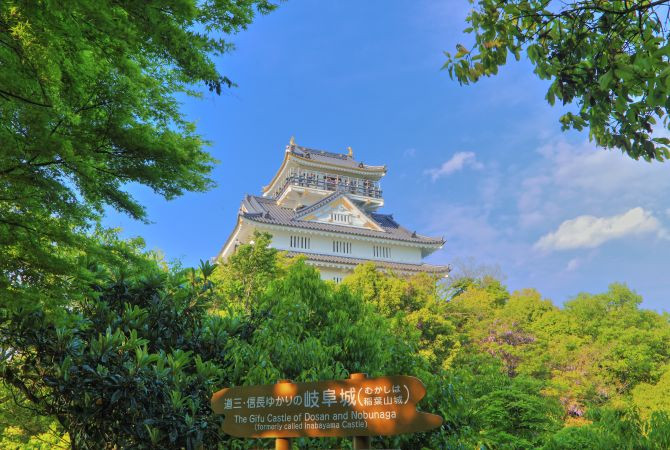 View of Gifu Castle atop Mount Kinka
View of Gifu Castle atop Mount Kinka
2.2 Great Buddha of Shoho-ji Temple: A Cultural Icon
The Great Buddha of Shoho-ji Temple is an impressive 14-meter-high statue that commemorates the victims of earthquakes and related diseases. This iconic statue, comparable to the Great Buddhas of Nara and Kamakura, is a testament to Gifu’s rich cultural heritage.
- Monumental Statue: The Buddha’s immense size and serene expression make it a captivating sight.
- Historical Significance: Built in the 19th century, the statue reflects Gifu’s resilience and compassion in the face of natural disasters.
- Tranquil Setting: The temple grounds offer a peaceful environment for reflection and appreciation of Japanese religious art.
- Cultural Heritage: The Great Buddha is an important symbol of Gifu’s cultural and spiritual identity.
- Artistic Achievement: The statue showcases the artistic skill and craftsmanship of the era in which it was created.
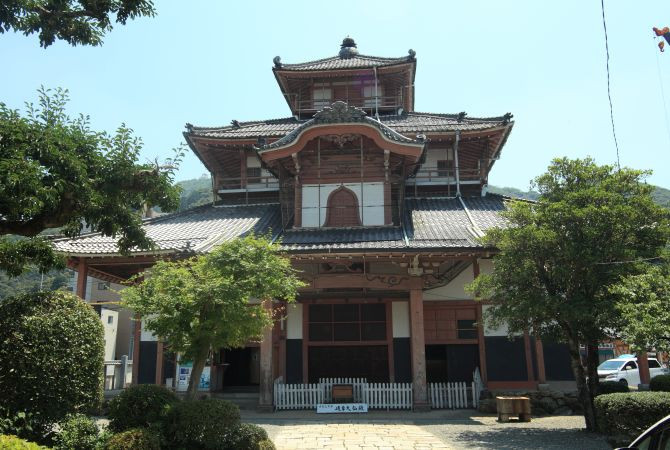 The Great Buddha of Shoho-ji Temple, a serene and monumental statue
The Great Buddha of Shoho-ji Temple, a serene and monumental statue
2.3 Ukai Cormorant Fishing: A Traditional Spectacle
Ukai Cormorant Fishing is a centuries-old tradition where skilled fishermen use cormorants to catch fish in the Nagara River. This unique fishing method, performed at night under the glow of torchlight, provides a mesmerizing cultural experience.
- Ancient Tradition: Ukai fishing dates back over 1,300 years and remains an integral part of Gifu’s cultural identity.
- Nighttime Performance: The fishing takes place at night, with the fishermen using flaming torches to attract fish.
- Skilled Fishermen: The fishermen, known as ushō, are highly skilled in handling the cormorants.
- Boat Tours: Visitors can observe the fishing from special viewing boats, often with meals served onboard.
- Cultural Significance: Ukai fishing is a symbol of Gifu’s commitment to preserving its traditional practices.
2.4 Ogaki Castle: A Detailed Reconstruction
Located a short train ride from Gifu City, Ogaki Castle is a meticulously reconstructed fortress that offers insights into the region’s feudal history. The castle played a significant role in the Battle of Sekigahara and houses a museum that brings this history to life.
- Historical Museum: The castle museum features exhibits that detail the history of Ogaki Castle and its role in the Battle of Sekigahara.
- Architectural Detail: The reconstruction accurately replicates the castle’s original 16th-century design.
- Strategic Location: Ogaki Castle’s proximity to the Sekigahara battlefield made it a crucial strategic point during the wars of the 16th century.
- Cultural Heritage: The castle symbolizes the resilience and historical importance of the Ogaki region.
- Feudal History: Visitors can learn about the feudal lords, samurai, and battles that shaped the region’s past.
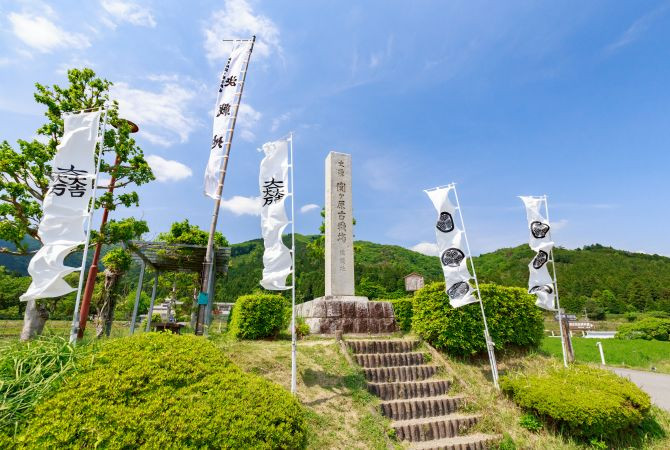 Ogaki Castle, a detailed reconstruction of a 16th-century fortress
Ogaki Castle, a detailed reconstruction of a 16th-century fortress
2.5 Sekigahara Battlefield: A Site of Historical Significance
Sekigahara is the site of one of Japan’s most decisive battles, where Tokugawa Ieyasu defeated Ishida Mitsunari in 1600, leading to the unification of the country and the establishment of the Tokugawa Shogunate.
- Historical Reenactments: The town hosts historical reenactments that bring the Battle of Sekigahara to life.
- Museum: The Sekigahara Town History and Folklore Museum provides detailed exhibits on the battle and its significance.
- Battlefield Tours: Visitors can explore the battlefield with guided tours, which offer insights into the strategies and events of the battle.
- Strategic Importance: The Battle of Sekigahara marked the end of the Sengoku period and the beginning of a long era of peace under the Tokugawa Shogunate.
- Monumental Significance: The battlefield serves as a memorial to the warriors who fought in this pivotal conflict.
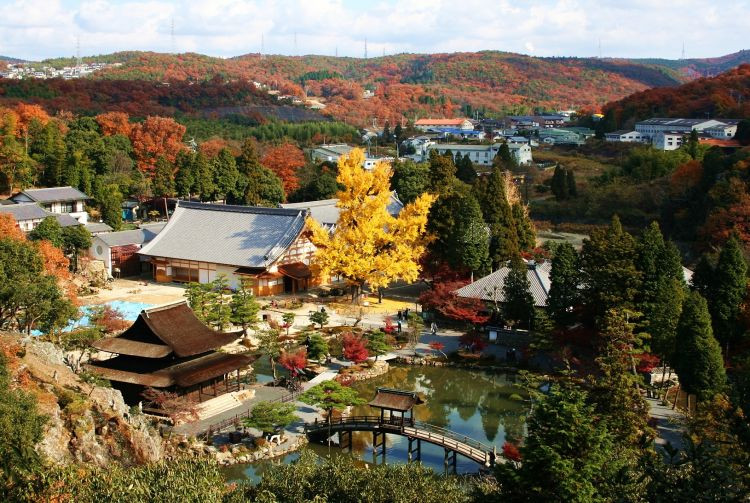 Sekigahara Battlefield, a site of monumental historical significance
Sekigahara Battlefield, a site of monumental historical significance
2.6 Tajimi: The Heart of Mino Pottery
Tajimi is renowned as the center of Mino-Yaki pottery, a type of Japanese ceramics celebrated worldwide. Visitors can explore numerous shops selling beautiful Mino-Yaki bowls, vases, and figures, and even try their hand at pottery making at the Ceramic Park.
- Mino-Yaki Pottery: Tajimi is famous for its Mino-Yaki ceramics, known for their unique styles such as Oribe and Shino ware.
- Ceramic Park MINO: This park allows visitors to create their own pottery and learn about the history and techniques of Mino-Yaki.
- Local Shops: Numerous shops in Tajimi offer a wide selection of Mino-Yaki pottery.
- Eiho-ji Temple: A beautiful temple complex with stunning gardens is also a must-visit in Tajimi.
- Artisan Workshops: Visitors can tour local workshops and observe skilled artisans at work.
2.7 Mino Washi Akari Art Festival: A Festival of Light
The Mino Washi Akari Art Festival, held annually in October, transforms the town of Mino into a magical display of light and art. Artists from around the world create intricate lanterns and light sculptures using handmade Mino paper (washi).
- Handmade Paper Art: The festival celebrates the traditional craft of Mino washi, a type of Japanese paper known for its quality and beauty.
- Evening Illumination: The streets of Mino are illuminated with artistic lanterns, creating a magical atmosphere.
- Cultural Exchange: The festival attracts artists and visitors from around the world, promoting cultural exchange and appreciation.
- Local Craftsmanship: The festival showcases the skills of local artisans and their dedication to preserving traditional crafts.
- Artistic Creativity: The festival is a platform for artists to express their creativity through light and paper.
3. Planning Your Trip to Gifu City with SIXT.VN
Planning a trip to Gifu City can be seamless and enjoyable with the right support. SIXT.VN offers a range of services designed to enhance your travel experience, from airport transfers to hotel bookings and guided tours.
3.1 How SIXT.VN Simplifies Your Travel Planning
SIXT.VN provides comprehensive travel services that cater to every aspect of your trip to Gifu City.
- Airport Transfers: Reliable and comfortable airport transfer services ensure a smooth start to your journey.
- Hotel Bookings: A wide selection of hotels to suit every budget and preference.
- Guided Tours: Expert-led tours to help you discover the best of Gifu City and its surroundings.
- Custom Itineraries: Personalized travel plans tailored to your interests and schedule.
- Multilingual Support: Assistance in multiple languages to address any concerns or queries.
3.2 Step-by-Step Guide to Booking Services on SIXT.VN
Booking travel services on SIXT.VN is easy and straightforward. Follow these steps to plan your trip:
- Visit SIXT.VN: Go to the SIXT.VN website.
- Select Your Service: Choose the service you need, such as airport transfer, hotel booking, or guided tour.
- Enter Your Details: Provide your travel dates, destination, and any specific requirements.
- Browse Options: Review the available options and select the one that best fits your needs.
- Confirm and Pay: Confirm your booking and make a secure payment through the website.
- Receive Confirmation: Receive a confirmation email with all the details of your booking.
3.3 Benefits of Using SIXT.VN for Your Gifu City Trip
Using SIXT.VN for your Gifu City trip offers numerous advantages that enhance your travel experience.
- Convenience: Easy online booking and comprehensive service offerings.
- Reliability: Dependable services that ensure a stress-free travel experience.
- Expertise: Local expertise to provide you with the best recommendations and support.
- Customization: Tailored itineraries and services to meet your specific needs.
- Support: Dedicated customer support to assist you at every step of your journey.
4. Exploring Gifu Prefecture: Beyond Gifu City
While Gifu City offers a wealth of attractions, the surrounding Gifu Prefecture is also rich in natural beauty, historical sites, and unique cultural experiences.
4.1 Shirakawa-go: A UNESCO World Heritage Site
Shirakawa-go is a picturesque village known for its traditional gassho-zukuri farmhouses, characterized by their steeply pitched thatched roofs that resemble hands clasped in prayer.
- Traditional Farmhouses: The unique architectural style of the gassho-zukuri houses is a major draw for visitors.
- Scenic Beauty: The village is nestled in a beautiful valley, surrounded by mountains and rice fields.
- Cultural Preservation: Shirakawa-go has preserved its traditional way of life, offering a glimpse into Japan’s rural past.
- Seasonal Charm: The village is beautiful in all seasons, with cherry blossoms in spring, lush greenery in summer, colorful foliage in autumn, and snow-covered landscapes in winter.
- UNESCO Recognition: As a UNESCO World Heritage Site, Shirakawa-go is recognized for its cultural and historical significance.
4.2 Takayama: A Historic Town
Takayama, located in the heart of the Japanese Alps, is a charming town known for its well-preserved old town, traditional crafts, and delicious local cuisine.
- Old Town: Takayama’s Sanmachi Suji district features beautifully preserved Edo-period buildings, shops, and sake breweries.
- Takayama Jinya: This historic government building offers insights into the town’s feudal past.
- Local Crafts: Takayama is known for its traditional crafts, including wood carving, lacquerware, and pottery.
- Festivals: The Takayama Spring and Autumn Festivals are among Japan’s most famous festivals, featuring elaborate floats and traditional performances.
- Japanese Alps: The town serves as a gateway to the Japanese Alps, offering opportunities for hiking and outdoor activities.
4.3 Gero Onsen: A Famous Hot Spring Resort
Gero Onsen is one of Japan’s three most famous hot spring resorts, known for its high-quality waters and relaxing atmosphere.
- Hot Spring Waters: The waters of Gero Onsen are renowned for their therapeutic properties, leaving the skin smooth and refreshed.
- Ryokans: Numerous traditional Japanese inns (ryokans) offer hot spring baths and exquisite cuisine.
- Scenic Beauty: The resort town is set along the banks of the Maze River, offering beautiful views and tranquil surroundings.
- Relaxation: Gero Onsen is the perfect place to unwind and rejuvenate.
- Onsen Culture: Visitors can experience traditional Japanese onsen culture, including bathing etiquette and relaxation techniques.
5. Practical Tips for Visiting Gifu City
To ensure a smooth and enjoyable trip to Gifu City, consider these practical tips regarding transportation, accommodation, local customs, and safety.
5.1 Transportation Options in Gifu City
Gifu City offers various transportation options, including trains, buses, and taxis. Understanding these options can help you navigate the city efficiently.
- Trains: Gifu Station is a major transportation hub, providing access to various parts of Gifu Prefecture and beyond.
- Buses: Local buses connect key attractions within Gifu City.
- Taxis: Taxis are readily available, offering a convenient but more expensive way to get around.
- Walking: Many attractions in central Gifu City are within walking distance of each other.
- Rental Cars: Renting a car can be useful for exploring the surrounding areas of Gifu Prefecture.
5.2 Accommodation Recommendations
Gifu City offers a range of accommodation options to suit different budgets and preferences.
- Hotels: Modern hotels in the city center offer convenient access to attractions and amenities.
- Ryokans: Traditional Japanese inns (ryokans) provide a cultural experience with tatami rooms, onsen baths, and traditional cuisine.
- Business Hotels: Budget-friendly business hotels offer basic amenities and a convenient location.
- Guesthouses: Guesthouses provide a more intimate and affordable lodging option.
- Location: Consider the location of your accommodation in relation to the attractions you plan to visit.
5.3 Understanding Local Customs and Etiquette
Respecting local customs and etiquette can enhance your travel experience and show appreciation for Japanese culture.
- Greetings: Bowing is a common form of greeting.
- Shoes: Remove your shoes when entering homes, temples, and some traditional restaurants.
- Dining: Use chopsticks correctly and avoid sticking them upright in a bowl of rice.
- Public Behavior: Be mindful of noise levels in public places and avoid talking loudly on trains.
- Tipping: Tipping is not customary in Japan.
5.4 Staying Safe in Gifu City
Gifu City is generally a safe destination, but it’s always important to take precautions to protect your belongings and ensure your well-being.
- Personal Belongings: Keep an eye on your belongings in crowded areas.
- Emergency Numbers: Know the local emergency numbers for police, fire, and ambulance.
- Health: Carry any necessary medications and be aware of local health facilities.
- Natural Disasters: Japan is prone to earthquakes and typhoons. Be aware of emergency procedures and follow local guidance.
- Information: Stay informed about any travel advisories or safety alerts.
6. Seasonal Highlights: When to Visit Gifu City
Gifu City offers unique attractions and experiences throughout the year. Understanding the seasonal highlights can help you plan your visit for the best possible experience.
6.1 Spring (March – May): Cherry Blossoms and Festivals
Spring is a popular time to visit Gifu City, with the cherry blossoms creating a beautiful backdrop for festivals and outdoor activities.
- Cherry Blossoms: The cherry blossoms typically bloom in late March to early April, attracting many visitors.
- Hanami: Enjoy hanami (flower viewing) picnics under the cherry trees.
- Spring Festivals: Many local festivals celebrate the arrival of spring.
- Outdoor Activities: The mild weather is perfect for hiking and exploring the city.
- Scenic Views: Visit parks and gardens to enjoy the spring scenery.
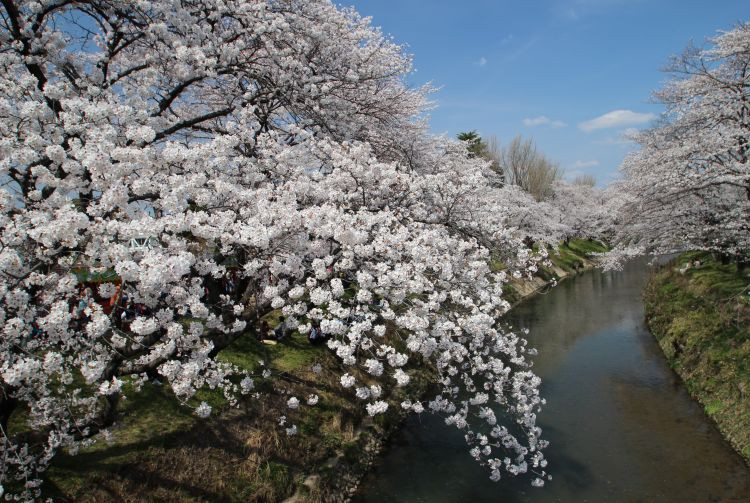 Cherry blossoms in Gifu, a beautiful sign of spring
Cherry blossoms in Gifu, a beautiful sign of spring
6.2 Summer (June – August): Lush Greenery and River Activities
Summer in Gifu City is characterized by lush greenery and opportunities for river activities, including the Ukai Cormorant Fishing.
- Ukai Fishing: Witness the traditional Ukai Cormorant Fishing on the Nagara River.
- River Activities: Enjoy boat rides and water sports on the Nagara River.
- Green Landscapes: The mountains and forests surrounding Gifu City are lush and green.
- Summer Festivals: Local summer festivals offer a chance to experience traditional Japanese culture.
- Hiking: Explore the hiking trails on Mount Kinka and other nearby mountains.
6.3 Autumn (September – November): Autumn Foliage and Cultural Events
Autumn is another popular time to visit Gifu City, with the autumn foliage creating stunning landscapes and numerous cultural events taking place.
- Autumn Foliage: The leaves change color in late October to November, creating beautiful scenery.
- Hiking: Enjoy hiking in the mountains to see the autumn foliage.
- Cultural Events: Attend local cultural events and festivals.
- Mino Washi Akari Art Festival: Experience the Mino Washi Akari Art Festival in October.
- Scenic Views: Visit parks and gardens to enjoy the autumn scenery.
6.4 Winter (December – February): Snowscapes and Winter Illuminations
Winter in Gifu City offers snowscapes and winter illuminations, creating a magical atmosphere.
- Snowscapes: The mountains surrounding Gifu City are covered in snow, creating beautiful winter landscapes.
- Winter Illuminations: Many areas of Gifu City are decorated with winter illuminations.
- Hot Springs: Relax in a hot spring (onsen) to warm up during the cold winter months.
- Winter Festivals: Local winter festivals offer a chance to experience traditional Japanese culture.
- Skiing: Go skiing or snowboarding at nearby ski resorts.
7. Delicious Local Cuisine: What to Eat in Gifu City
Gifu City offers a variety of delicious local cuisine that reflects the region’s unique ingredients and culinary traditions.
7.1 Hoba Miso: A Regional Delicacy
Hoba miso is a regional specialty consisting of miso grilled on a hoba leaf (magnolia leaf). It is often served with vegetables, mushrooms, and meat.
- Unique Flavor: The hoba leaf imparts a unique flavor to the miso.
- Local Ingredients: The dish features local ingredients such as miso, vegetables, mushrooms, and meat.
- Traditional Cooking Method: The miso is grilled on a hoba leaf, which is a traditional cooking method in the region.
- Regional Specialty: Hoba miso is a must-try dish when visiting Gifu City.
- Warm and Comforting: The dish is warm and comforting, making it perfect for colder months.
7.2 Ayu (Sweetfish): A Local Delicacy
Ayu (sweetfish) is a popular local delicacy, often grilled or served as sashimi.
- Fresh Flavor: Ayu has a fresh, delicate flavor.
- Local Catch: The fish is caught in the Nagara River.
- Grilled Ayu: Grilled ayu is a popular dish, often served with salt.
- Ayu Sashimi: Ayu can also be served as sashimi, allowing you to savor its fresh flavor.
- Seasonal Dish: Ayu is typically available during the summer months.
7.3 Gifu Ramen: A Local Noodle Dish
Gifu ramen is a local variation of ramen, featuring a unique broth and toppings.
- Unique Broth: Gifu ramen is known for its distinct broth.
- Local Toppings: The ramen features local toppings.
- Noodle Dish: The dish is a hearty and flavorful noodle soup.
- Ramen Shops: Numerous ramen shops in Gifu City serve Gifu ramen.
- Comfort Food: Ramen is a popular comfort food in Japan.
8. Frequently Asked Questions (FAQ) About Gifu City Tourism
Here are some frequently asked questions about planning a trip to Gifu City:
8.1 What is Gifu City known for?
Gifu City is known for its historical significance, Gifu Castle, Ukai Cormorant Fishing, and Mino-Yaki pottery.
8.2 When is the best time to visit Gifu City?
The best times to visit Gifu City are in spring (for cherry blossoms) and autumn (for autumn foliage).
8.3 How do I get to Gifu City from Nagoya?
You can easily reach Gifu City from Nagoya by train, which takes about 30 minutes.
8.4 What are the must-see attractions in Gifu City?
Must-see attractions in Gifu City include Gifu Castle, the Great Buddha of Shoho-ji Temple, and Ukai Cormorant Fishing.
8.5 Is Gifu City a safe place to visit?
Yes, Gifu City is generally a safe place to visit.
8.6 What local cuisine should I try in Gifu City?
You should try Hoba Miso, Ayu (Sweetfish), and Gifu Ramen.
8.7 How can SIXT.VN help me plan my trip to Gifu City?
SIXT.VN offers airport transfers, hotel bookings, guided tours, and custom itineraries to help you plan your trip.
8.8 Are there any UNESCO World Heritage Sites near Gifu City?
Yes, Shirakawa-go, a UNESCO World Heritage Site, is located near Gifu City.
8.9 What is Ukai Cormorant Fishing?
Ukai Cormorant Fishing is a traditional fishing method where fishermen use cormorants to catch fish in the Nagara River.
8.10 What is Mino-Yaki pottery?
Mino-Yaki pottery is a type of Japanese ceramics known for its unique styles, such as Oribe and Shino ware, produced in the Tajimi region of Gifu Prefecture.
9. Conclusion: Your Gifu City Adventure Awaits
Gifu City offers a unique blend of history, culture, and natural beauty that makes it an unforgettable destination. With its iconic castle, traditional crafts, and stunning landscapes, Gifu City promises a captivating journey for every traveler. Let SIXT.VN enhance your travel experience with convenient airport transfers, comfortable hotel bookings, and expert-led guided tours. Plan your adventure today and discover the wonders of Gifu City.
Ready to explore Gifu City? Contact SIXT.VN today to book your airport transfer, hotel, and guided tour. Visit SIXT.VN or call +84 986 244 358 to start planning your dream trip to Gifu City Address: 260 Cau Giay, Hanoi, Vietnam. Your unforgettable Gifu adventure awaits!



